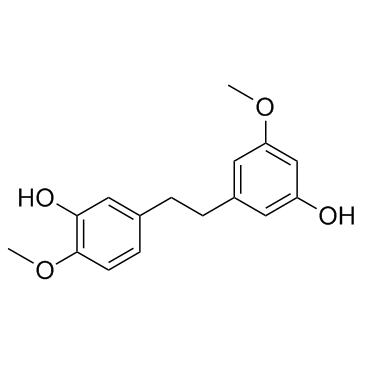
Gigantol
CAS No. 67884-30-4
Gigantol ( —— )
产品货号. M18985 CAS No. 67884-30-4
Gigantol 是一种新型 Wnt/β-catenin 通路抑制剂。它通过下调乳腺癌细胞中磷酸化的 LRP6 和胞质 β-连环蛋白来抑制 Wnt/β-连环蛋白信号传导。
纯度: >98% (HPLC)
 COA
COA
 Datasheet
Datasheet
 HNMR
HNMR
 HPLC
HPLC
 MSDS
MSDS
 Handing Instructions
Handing Instructions
| 规格 | 价格/人民币 | 库存 | 数量 |
| 5MG | ¥1466 | 有现货 |


|
| 10MG | ¥2203 | 有现货 |


|
| 25MG | ¥3540 | 有现货 |


|
| 50MG | ¥4844 | 有现货 |


|
| 100MG | ¥6909 | 有现货 |


|
| 200MG | 获取报价 | 有现货 |


|
| 500MG | 获取报价 | 有现货 |


|
| 1G | 获取报价 | 有现货 |


|
生物学信息
-
产品名称Gigantol
-
注意事项本公司产品仅用于科研实验,不得用于人体或动物的临床与诊断
-
产品简述Gigantol 是一种新型 Wnt/β-catenin 通路抑制剂。它通过下调乳腺癌细胞中磷酸化的 LRP6 和胞质 β-连环蛋白来抑制 Wnt/β-连环蛋白信号传导。
-
产品描述Gigantol is a novel inhibitor of the Wnt/β-catenin pathway. It inhibits Wnt/β-catenin signaling through downregulation of phosphorylated LRP6 and cytosolic β-catenin in breast cancer cells. Gigantol may be developed as a promising neuroprotective agent for successful MSC transplantation in ischemic diseases, it shows the protective effect against hydrogen peroxide-induced apoptosis in rat bone marrow mesenchymal stem cells through the PI3K/Akt pathway.Gigantol inhibits aldose reductase gene to exert its anti-cataract activity. Gigantol induces growth inhibition and apoptosis of HepG2 cells via the PI3K/Akt/NF-κB signaling pathway.Gigantol also shows α-glucosidase inhibitory activity.
-
体外实验Gigantol isomer-1 decreases the level of phosphorylated LRP6 and cytosolic β-catenin in HEK293 cells. In breast cancer MDA-MB-231 and MDA-MB-468 cells, treatment with Gigantol isomer-1 reduces the level of phosphorylated LRP6. Gigantol isomer-1 significantly inhibits the proliferation and induces apoptosis of the HepG2 cells. Gigantol isomer-1 at concentrations of 1, 40 and 150 μM markedly decreases the cell viability by 11.7, 30.0 and 56.4% at 24 h and 21.1, 66.8 and 85.5% at 48 h, respectively. The IC50 value is 9.30 μM.
-
体内实验LDD and Gigantol isomer-1 (25–100 mg/kg, p.o.) significantly increase the hot-plate latency in comparison to vehicle-treated mice and decreased carrageenaninduced inflammation in rats.
-
同义词——
-
通路Others
-
靶点Other Targets
-
受体β-catenin| α-glucosidase
-
研究领域Cancer
-
适应症——
化学信息
-
CAS Number67884-30-4
-
分子量274.31
-
分子式C16H18O4
-
纯度>98% (HPLC)
-
溶解度DMSO : ≥ 160 mg/mL; 583.28 mM
-
SMILESCOc1cc(O)cc(CCc2ccc(OC)c(O)c2)c1
-
化学全称——
运输与储存
-
储存条件(-20℃)
-
运输条件With Ice Pack
-
稳定性≥ 2 years
参考文献
1. Yu S, et al. Bmc Complementary & Alternative Medicine, 2018, 18(1):59.
产品手册




关联产品
-
Licoricesaponin H2
甘草皂苷H2是一种天然产物。
-
5NAA
5NAA是一种硝基芳香族化合物。 5NAA也是合成染料和其他硝基芳香族化合物的起始原料。 5NAA 是疥疮链霉菌分泌的分子。
-
Acesulfame Potassium
安赛蜜钾是一种非营养性甜味剂。



 021-51111890
021-51111890 购物车()
购物车()
 sales@molnova.cn
sales@molnova.cn







